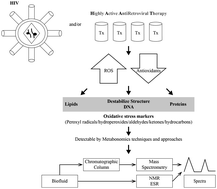当前位置:
X-MOL 学术
›
Mol. Biosyst.
›
论文详情
Our official English website, www.x-mol.net, welcomes your feedback! (Note: you will need to create a separate account there.)
HIV/HAART-associated oxidative stress is detectable by metabonomics
Molecular BioSystems Pub Date : 2017-09-18 00:00:00 , DOI: 10.1039/c7mb00336f Aurelia A. Williams 1, 2, 3, 4 , Lungile J. Sitole 4, 5, 6, 7 , Debra Meyer 4, 5, 6, 7
Molecular BioSystems Pub Date : 2017-09-18 00:00:00 , DOI: 10.1039/c7mb00336f Aurelia A. Williams 1, 2, 3, 4 , Lungile J. Sitole 4, 5, 6, 7 , Debra Meyer 4, 5, 6, 7
Affiliation

|
Chronic human immunodeficiency virus (HIV) infection, separately and in combination with highly active antiretroviral therapy (HAART) is closely associated with oxidative stress (OS). Most studies demonstrating redox imbalances in HIV-infected individuals have done so using conventional biochemical methodologies. The limited simultaneous detection of multiple OS markers within one sample is a major drawback of these methodologies and can be addressed through the use of metabonomics. HIV-metabonomic studies utilizing biofluids from HAART cohorts as the investigative source, are on the increase. Data from many of these studies identified metabolic markers indicative of HIV-induced OS, usually as an outcome of an untargeted metabonomics study. Untargeted studies cast a wide net for any and all detectable metabolites in complex mixtures. Given the prevalence of OS during HIV infection and antiviral treatment, it is perhaps not surprising that indicators of this malady would become evident during metabolite identification. At times, targeted studies for specific (non-OS) metabolites would also yield OS markers as an outcome. This review examines the findings of these studies by first providing the necessary background information on OS and the main ways in which free radicals/reactive oxygen species (ROS) produced during OS, cause biomolecular damage. This is followed by information on the biomarkers which come about as a result of free radical damage and the techniques used for assaying these stress indicators. The established links between elevated ROS and lowered antioxidants during HIV infection and the subsequent use of HAART is then presented followed by a review of the OS markers detected in HIV metabonomic studies to date. We identify gaps in HIV/HAART-associated OS research and finally suggest how these research gaps can be addressed through metabonomic analysis, specifically targeting the multiple markers of HIV-induced OS.
中文翻译:

代谢组学可检测到HIV / HAART相关的氧化应激
慢性人免疫缺陷病毒(HIV)感染单独或与高活性抗逆转录病毒疗法(HAART)结合与氧化应激(OS)密切相关。多数证明艾滋病毒感染者中氧化还原失衡的研究都是使用常规生化方法进行的。在一个样品中同时检测多个OS标记物有限,这是这些方法的主要缺点,可以通过使用代谢组学解决。利用来自HAART人群的生物流体作为研究来源的HIV代谢组学研究正在不断增加。这些研究中的许多数据确定了指示HIV诱发OS的代谢标记物,通常是无针对性的代谢组学研究的结果。无目标研究为复杂混合物中的任何和所有可检测的代谢物提供了广阔的网络。考虑到在HIV感染和抗病毒治疗期间OS的患病率,在鉴定代谢物期间会明显显示出这种疾病的迹象可能并不奇怪。有时,针对特定(非OS)代谢产物的靶向研究也会产生OS标记物作为结果。这篇综述通过首先提供有关OS的必要背景信息以及OS期间产生的自由基/活性氧物质(ROS)引起生物分子损害的主要方式来检查这些研究的结果。随后是有关由于自由基损伤而产生的生物标志物的信息以及用于测定这些应激指标的技术。然后介绍了在HIV感染期间ROS升高和抗氧化剂水平降低之间建立的联系,以及随后使用HAART,然后回顾了迄今为止在HIV代谢组学研究中检测到的OS标记。我们确定了与HIV / HAART相关的OS研究中的差距,最后提出了如何通过代谢组学分析来解决这些研究差距的方法,特别是针对HIV诱导的OS的多个标志物。
更新日期:2017-10-25
中文翻译:

代谢组学可检测到HIV / HAART相关的氧化应激
慢性人免疫缺陷病毒(HIV)感染单独或与高活性抗逆转录病毒疗法(HAART)结合与氧化应激(OS)密切相关。多数证明艾滋病毒感染者中氧化还原失衡的研究都是使用常规生化方法进行的。在一个样品中同时检测多个OS标记物有限,这是这些方法的主要缺点,可以通过使用代谢组学解决。利用来自HAART人群的生物流体作为研究来源的HIV代谢组学研究正在不断增加。这些研究中的许多数据确定了指示HIV诱发OS的代谢标记物,通常是无针对性的代谢组学研究的结果。无目标研究为复杂混合物中的任何和所有可检测的代谢物提供了广阔的网络。考虑到在HIV感染和抗病毒治疗期间OS的患病率,在鉴定代谢物期间会明显显示出这种疾病的迹象可能并不奇怪。有时,针对特定(非OS)代谢产物的靶向研究也会产生OS标记物作为结果。这篇综述通过首先提供有关OS的必要背景信息以及OS期间产生的自由基/活性氧物质(ROS)引起生物分子损害的主要方式来检查这些研究的结果。随后是有关由于自由基损伤而产生的生物标志物的信息以及用于测定这些应激指标的技术。然后介绍了在HIV感染期间ROS升高和抗氧化剂水平降低之间建立的联系,以及随后使用HAART,然后回顾了迄今为止在HIV代谢组学研究中检测到的OS标记。我们确定了与HIV / HAART相关的OS研究中的差距,最后提出了如何通过代谢组学分析来解决这些研究差距的方法,特别是针对HIV诱导的OS的多个标志物。


























 京公网安备 11010802027423号
京公网安备 11010802027423号